Are you looking to upgrade your Honda CRF230F? There are many parts you can add to make it faster and more comfortable. This is the ultimate list of CRF230 mods that actually improve its performance.
Are you ready to turn your "Little girl's bike" into a "sleeper bike" that will make guys on bigger bikes look twice when passing them on the trails or track? I must warn you, though…
The more mods you do, the more addicting it gets. And the more giggles you will have under your helmet when riding this "Little Red Pig".
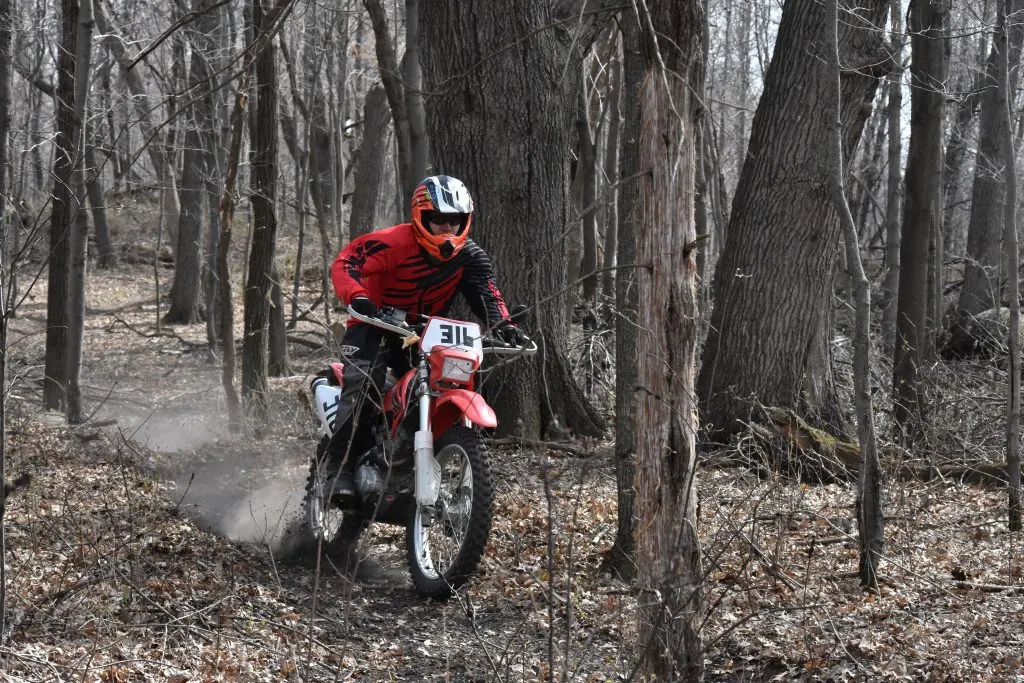
Performance Mods Part 1
This will be a 2 part series, just like when I covered the list of XR200 mods. Part 1 will be all about performance modifications that will make your CRF230 faster or make it easier to ride, which in turn will make you faster because you are more comfortable on it.
Some of these mods are free or cheap for how much of a difference they make. The CRF230F will never be the best motocross bike, but there's a lot of potential hiding underneath. If you enjoy trail riding in the woods, mountains, or any kind of single-track, then you're in for a surprise...
Is The CRF230F Power-Up Jet Kit Worth It?
Honda builds their off-road trail bikes to meet EPA and emission standards in certain countries. This means that they will run too lean in most climates.
The CRF230 definitely needs to be re-jetted to get the most performance out of it. This includes both stock or modified 230F's.
Many 230 owners may realize this and do a quick search to find that there is a "CRF230 Power Up Jet Kit" (Amazon). This kit includes a new special needle, a couple different main jet sizes, and a new pilot jet. The cost is about $50, which is reasonable for an upgrade that makes a noticeable difference.
DIY & Save A Few Bucks
If you like tinkering on your bike with mods, then there's a cheaper way to get the same amount of performance as the Power Up Jet Kit. Instead, you can buy individual main and pilot jets in addition to a stock 2003-2005 CRF230F needle.
Stock Honda CRF230F Jetting Specs
The stock jetting on a CRF230F is lean for most climates, which is why the Power Up Jet kit (Amazon) is available. The stock pilot jet is a 42 and the main jet is a 110. Going up to a 45 pilot and a 120 main will gain power and throttle response in most cases.
The 2003-2005 CRF230 comes with an adjustable needle. Going from the middle clip position to the 4th position from the top should also make an improvement.
Why Different Main Jets?
The power up jet kit needle has a different taper, so it requires a richer main jet than if you run the stock 03-05 needle.
For example:
If you have the power-up needle then it will run better with a 132-135 main jet if your bike is stock for average climates. A 120 main will run better with the stock 03-05 CRF230F needle.
How To Un-Cork Your CRF230F
A lot of trail bikes come corked or choked up from the factory. Usually for emission and sound limit reasons to meet EPA requirements. Changing the jets in the carb, as you just read, was part of the un-corking process.
The CRF230 has a baffle/restrictor on the intake and exhaust. These do help keep the sound output down, but they're limiting some potential power.
To un-cork a Honda CRF230F, simply remove the intake air box lid and exhaust baffle. Jetting must be changed if it's still stock from the factory.
Air Box
The CRF230 has an average-sized air box, but there's not much room for air to get in to reach the carb. The more air you can get through the carb, the more potential gas you can get through it as well, which will make more power.
This is theoretical, of course, because the engine has to be able to properly burn all of that air and fuel to make the power.
Why do we install bigger carbs on dirt bikes? They suck more air in to boost the horsepower (when properly tuned). However, other factors come into play, such as the velocity of the air. Air velocity is how fast the air is going through the intake, which plays a bigger role in low-end torque.
For example, when you go to a bigger carb the top-end power is increased, but some low-end torque is usually lost. Getting into the science of it is interesting, but that's not what this article is about.
Remove The Lid
There is a lid on the top of the airbox that can be removed to make the opening bigger. You'll need to take the seat off to access it.
A little more dust will be able to get in, but it's generally worth it if you're looking for more power. This is why it's important to have a quality air filter that is regularly cleaned or changed.
Air Filter
Going to a quality aftermarket air filter will also allow more air through, giving you more power and better throttle response. Just remember to keep it clean, especially if you ride in sandy/dusty areas.
Muffler Baffle/End Cap
While the stock head pipe is the biggest restriction (more on this later), the factory muffler on the Honda 230 has a baffle with a built-in spark arrestor on it. This can be removed to gain some low-end torque and throttle response.
However, this will greatly increase the sound decibel output. I don't recommend this modification if you live in a suburban area with neighbors close by or if you ride at a trail/park that requires a USFS approved spark arrestor.
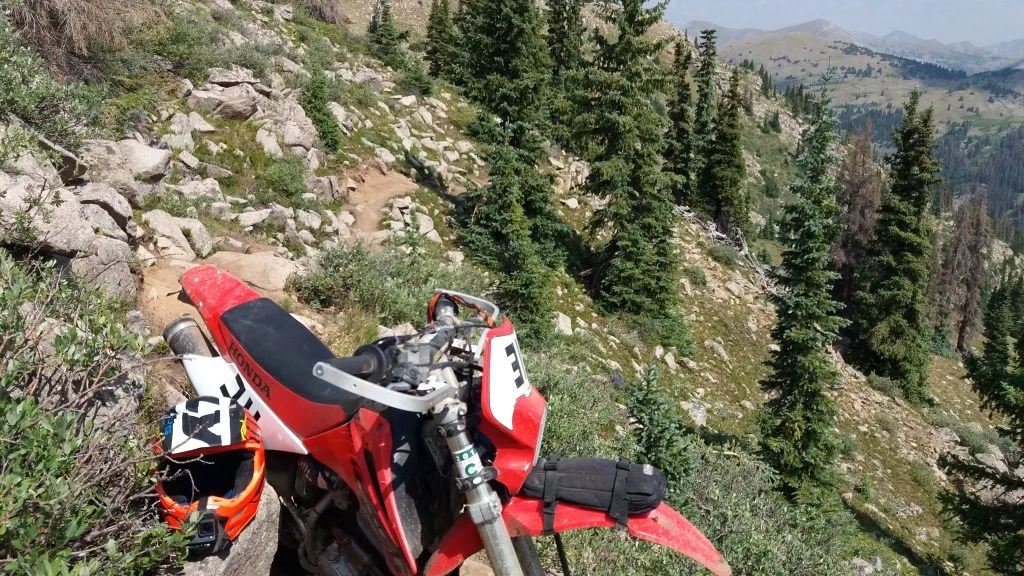
CRF230 Suspension upgrades
The last part of a trail bike that gets a technology update is usually the suspension. This is because affordable trail bikes are built for a beginner rider or someone that doesn’t have enough experience to tell a difference between good and bad suspension.
The CRF230F suspension is 1970s technology, but that’s okay. It’s super simple, easy to work on, and reliable. The problem is that once you start riding at higher speeds over rough terrain, the stock forks and shock will beat you up and may even throw you off the bike.
Having properly setup suspension for YOU is important for safety, but learning proper riding techniques is even more important and can make up for poor suspension to a point.
What's Your Budget & Timeframe?
There are several options available for modifying or upgrading your CRF230 suspension, but the best options are hundreds of dollars. If you plan on keeping this bike for years to come, it may be worth your time, effort, and investment.
Rear Shock upgrade
The rear shock is the most troublesome part on the CRF230 when it comes to performance. Honda continues to ignore this subpar, yet vital suspension component that can cause safety issues if you are an aggressive rider.
Stock Shock Woes
The stock shock on the 230 actually has a good spring rate for a medium-sized beginner trail rider, but you can get a stiffer spring (Amazon) if you weigh over 200 lbs. The main problem is the internal valving that can and will give you a hard time riding on rough terrain when you push the pace hard enough.
The rebound damping is too slow. This is a problem when you have two consecutive bumps or obstacles that will compress the rear shock in a short amount of time.
Has the stock shock put you on the ground?
The first bump will compress the shock, but the shock rebounds too slowly. By the time you hit the second bump the shock is still trying to rebound.
This will compress it even more than the first bump did. After that is when it will try to buck you off because it now can fully rebound, but it has a lot more built-up force from compressing twice.
Stock Shock Re-Valve
The stock shock can be re-valved by a professional, such as Bruce Triplett or John Hlebo, but even Bruce says that the stock CRF230F shock is limited. However, it's the most affordable shock upgrade and will definitely make a difference, even if you're an average rider with little experience.
Depending on who you send it to, it'll be around 200 bucks. That's not very expensive for a re-valve, but you're missing out on any external adjustments for better performance, aside from the spring pre-load.
Vonkat rear shock upgrade
The newest rear shock option for the CRF230 might be the best value and performance for your money. The Vonkat rear shock (Amazon) is a great option if you're an aggressive or heavier rider for a few reasons.
Vonkat shock advantages:
- More suspension/wheel travel = better potential performance
- 2.5 lbs lighter than stock - that's HUGE (less unsprung weight = better handling)
- Bigger shock shaft (18) - more durable for aggressive riding
- 20 clicker rebound damping adjustment - tune for better comfort/traction
- Air adjustable spring assist for even more tunability
- Rebuildable - the stock shock is not made to be easily rebuildable
Even Torture Test says that it's a great bolt-on mod if you're looking for the most performance for your money. Compared to the Hagon shock, it's set up for faster and heavier riders.
Hagon Shock
A Hagon rear shock is a complete aftermarket shock for the 230F. It's a big improvement over the stock shock, but it's still limited due to a lack of adjustability. It has a compression/rebound clicker adjustment, and the pre-load can be adjusted. There's no remote reservoir or high-speed damping.
Can you lower the seat height?
Yes, there are a few ways to lower your CRF230F seat height, but they all affect the handling or ergonomics. For example, a lowering link (Amazon) is a simple and easy way to make your 230 close to 2" inches lower in the rear, which is great if you or your wife has short legs but still wants a full-size dirt bike.
To keep the front suspension balanced with the lowered rear, you'll want to lower the forks as well, either with a spacer or dropping the triple clamp height. A lowering link will make the steering slower, but if you're a beginner you probably won't notice much of a difference.
It's a nice mod that's easy to put back to the original setting when you're ready for a higher ground clearance or want to sell your bike.
Works/Other Shocks
There are other aftermarket shocks that seem to come and go as far as resale and availability. The best shocks for a CRF230F generally have a remote reservoir with complete compression and rebound damping adjustment, as well as high speed compression damping.
High speed damping control is great for trail bikes because it can make a choppy ride feel plush without bottoming out easily. High speed compression damping controls the compression speed when you hit obstacles that compress the suspension at a high rate of speed.
This would include small bumps, rocks, roots, etc. Being able to soften it up for the small stuff without effecting the suspension on bigger hits will make your ride softer so you'll be able to ride longer.
Front Fork Upgrades
The stock CRF230F forks are adequate for a new rider, but they are very soft and one-dimensional. They only have about 9.5" of travel, so this is one of the biggest disadvantages compared to other full size trail bikes with 11-12 inches of suspension travel.
Budget DIY fork upgrade
The stock 230 forks can be modified. Heavy duty springs (Amazon) are a common and fairly easy mod, but that only makes them a stiffer one-dimensional set of forks.
When I say one-dimensional, I mean that the rate at which the forks compress is the same throughout the entire stroke. This is due to there only being one hole on each damper rod for the fork oil to flow through. This is referred to as suspension damping.
You can also use heavier-weight fork oil (Amazon) to slow down the compression and rebound damping even more. If you're already replacing the stock fork springs, then it's easy to use heavier oil to make it stiffer and help prevent bottoming the forks.
Stock Fork Re-valve Mod
I like to work on and modify my own bikes and parts, but when it comes to suspension work that I’ve never done before, I consider sending it to someone and see what they did and how it works.
In the case of my CRF230, I sent my stock fork damper rods and springs to Bruce Triplett because he knows his stuff when it comes to older style RSU (right-side-up) forks. The 230 community regard him as the guru for the stock suspension components and how to set them up for each person's weight and riding ability.
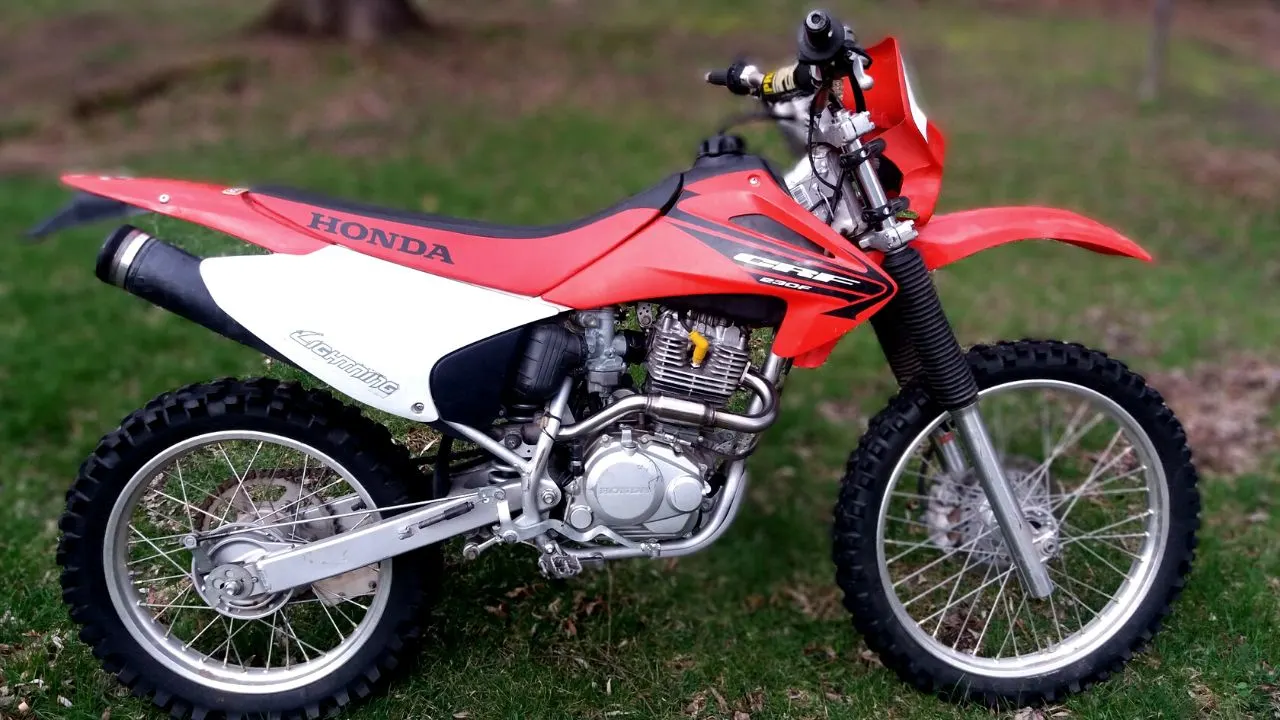
For a little more than 100 bucks I got them back and installed them myself. I was greatly impressed because the damping was much more progressive, and the pre-load was spot on for my weight.
For the best budget fork upgrade, a good tuner like Bruce is the way to go, especially if you’re intimidated by working on the suspension. He is extremely easy to talk to and will explain everything in detail. His speed and cost are beyond fair in my opinion.
CRF230F Fork Conversions - From different bikes?
There are numerous fork conversions that have been done to the CRF230F. Whichever kind of fork setup you want depends on how much work you're willing to do.
CR85 to CRF230 Fork Conversion
Probably the first and most popular fork swap was the CR80/CR85 forks, which is what I have on my 230. They are one of the lightest forks that can be fitted to this bike.
Adapter kits were being made by at least one manufacturer/person, but they can be difficult to source if you don't have the resources to make your own adapter parts.
The CR85 forks require a lower triple clamp relief mod for the steering stem to be long enough, wheel spacers, brake caliper adapters, fender mounting mods, and a longer brake line. There are probably a couple of other small things to make everything fit and work.
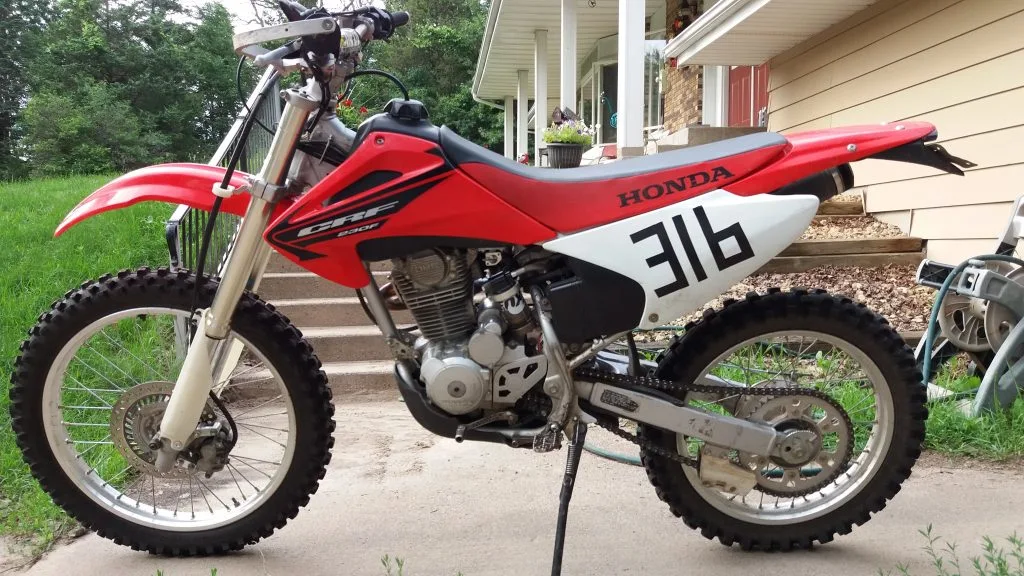
Then there's setting up the fork spring rate and valving. Stiffer springs are required, but the valving needs to be softer for trail riding, or else it will be a harsh ride. If properly set up, these forks are on another level compared to the stock 230F forks. Having extra travel helps too.
XR400 Fork Swap
The latest popular fork conversion is taking a complete XR400 front-end and bolting it onto the CRF230 chassis. There are still some small mods that need to be done, such as shortening the steering stem, but these are very capable forks, especially after some valving changes.
Tires
Do you have the original tires on your CRF230? Even if they still have plenty of tread left, going to a different tire for the appropriate terrain will be an upgrade.
After suspension, tires are the biggest factor to riding comfortably and confident, which will accelerate your skill and speed. I really like the Shinko F546 (Amazon) on the front and a IRC VE33 (Amazon) on the rear. They both work well in every terrain I've ridden my 230F.
Upgraded CDI Box
The CDI (ignition box) controls the timing of the spark that produces combustion for the engine. The stock CRF230F CDI is very mellow, to put it plainly. It's a lazy ignition curve so that the power-curve is smooth, and soft, and it won't cause any pre-ignition problems.
An aftermarket ignition (Amazon) will advance the spark at all or certain RPM ranges. What this means is that the spark plug will ignite and the combustion will begin at a sooner point of the engine rotation. This helps burn the mixture and push the piston back down at the right time to make more power.
There's a point at which advancing will do more harm than good. The result will be a loss in power and it can pre-ignite the air/fuel mixture. You shouldn't need to worry about that on the CRF 230 unless you are running extremely high compression.
ProCom or BBR CDI
The best bang for your buck is going to be a ProCom CDI (Amazon). It advances the spark mostly at low RPM speeds. This will help boost low-end torque, which is where this bike shines.
Since it's physically smaller than the stock CDI, you'll want to add some foam and/or zip-tie to help keep it secure on the frame.
The rev-limiter is also increased, but the CRF230 is useless at that high of an RPM. Once it goes past 8k it's going downhill in the horsepower department.
If you can't find one then the BBR unit (Amazon) is your next best choice.
Exhaust
Did you know that the CRF230F and CRF150F (03-05) share the same size head pipe? Honda wanted to save money, so they didn't develop a new head pipe that works better for the larger engine, so they used the pipe from the smaller engine.
This is a choke point, so going with a larger diameter header pipe will provide a noticeable power gain even if your engine is stock.
Is The Muffler Junk Too?
The 230 muffler is actually not that bad. Yes, the baffle is somewhat restrictive, but the muffler itself flows well enough to use a larger head pipe with it.
Going with a full aftermarket exhaust system can yield the most improvement, but it costs more and is generally louder.
Which Exhaust Is Best?
Pretty much any aftermarket exhaust is going to be better than a stock system if it's properly jetted. It mainly depends on the look, sound, and price you want to pay for it.
Cheap Knock-Off Exhaust System
If you're on a tight budget, the Stonemen full exhaust or the JFG Racing exhaust system (Amazon) is as cheap as it gets while still giving you performance. At about 100 bucks, you wonder how they can sell them…
The quality of materials and fitment probably won't be the greatest. You might just need to help it along to fit, but you may not have any problem at all. It's not a dyno-proven exhaust, so don't expect massive horsepower gains for your CRF230.
Pro Circuit T4 System
The Pro Circuit T6 exhaust system (Motosport) is my recommendation for the best bang for your buck in performance, quality and price. It looks good and sounds good too. The head pipe has multiple diameters (stepped head pipe gets bigger each section), which is perfect for providing broad, mid-range power.
The PC T6 is going to be louder than a stock pipe, but it's not obnoxious. For around 250, you're not going to find many other name-brand complete exhausts unless they're used. It also comes with a USFS approved spark arrestor on the end cap.
Yoshimura RS2 System
Yoshimura is well known for making high quality performance exhausts in the dirt bike industry. The build quality and durability is great, and with the quiet insert, it's one of the quietest pipes while still giving you more power than stock.
The Yoshimura RS2 Comp Series exhaust (MotoSport) comes with a USFS approved spark arrestor for the CRF230F.
My Personal Review
I personally have an FMF Megabomb head pipe with the stock muffler and a custom end cap on my CRF230F. The FMF header has a reduced diameter where it meets the midpipe/stock muffler joint, so it still restricts flow even though it's larger than stock up until that point.
Out of the above options, I would probably go with the Yoshimura or Pro Circuit (Motosport) exhaust system if I had to do it over again. That way I get the whole system without needing to do any mods later to open it up more.
Carb Upgrade
The stock carburetor is another choke point on the CRF230F. Upgrading to a larger carb will most likely gain horsepower, but you may lose torque if you choose the wrong one.
XL250 OEM Carb
The old Honda XL250 carb is basically the easiest bolt-on performance carb upgrade for the CRF230. The problem is, they're hard to find, and they usually need a rebuild with replacement parts that are hard to find in stock.
The reason why the XL250 carb is better is primarily because of the accelerator pump. The AP is a mechanical pump that squirts a small shot of fuel through the carb at low RPM throttle openings. This extra fuel produces more low-end power and throttle response because it helps get rid of that lean spot.
Why The Stock Carb Sucks
Old, round slide carbs, like what the stock CRF230F has, are not efficient at low RPM. There’s a lot that goes into that but that’s for another article.
If you’ve ever snapped the throttle open quickly from a low RPM, you’ve probably felt the bog or hesitation before it starts accelerating. This is a lean bog because the engine can’t burn the fuel at the same rate that air is coming in.
Adding a little extra fuel from the AP counteracts that, giving you more “snap” at the low-end, which is great for getting up hills in a lower gear or popping the front wheel up to get over a fallen log.
XL250 Chinese Copy Carb
There’s a Chinese copy of the XL250 carburetor (Amazon) on eBay for less than $50, but the quality isn’t quite the same. Many CRF230 owners that have done this carb swap needed to buy two of these carbs and swap out good working parts from each of them to make one complete functioning carb. The accelerator pump and nozzle will probably need to be adjusted as well on this copycat carb or else you won’t get the benefit.
If you like tinkering with stuff and saving money, this route may work out well for you.
Keihin PWK28 Carb Conversion
A genuine Keihin PWK 28 carb (Amazon) is well known to be a great carb upgrade for the CRF230F, even if your engine is stock. It's smaller, lighter, easy to tune, and it outperforms the stock carb in every way.
The biggest setback is the cost and time to adapt it to the CRF230 intake manifold. A new genuine PWK28 is over 200 bucks, but setup with the right jetting and it's ready to go with some adapters and a different throttle assembly. The stock carb has push and pull cables while the PWK just has one pull cable.

Adapters are needed because it's shorter than the stock carb and the inlet/outlet diameters are smaller. They can be machined and pressed on, or you can get creative with some tubing from a local hardware/tool supply store.
If you can get creative with the carb mounting and want to try it on a budget, you can get a knock-off JFG Racing PWK 28mm carb on Amazon, but you'll most likely need to play around with the jetting specs.
Big Bore Kit
There's no replacement for displacement. You have a number of options for increasing the engine size on your CRF 230. A big bore piston kit from BBR (Amazon) is available if you want to bore your stock cylinder out. This should be done by a machinist that can hold proper tolerances.
Athena has a complete big bore kit that comes with a new cylinder and piston kit already matched to size. The best part? It's not much more expensive than a big bore piston kit. It's higher compression but can still be run on premium pump gas. To read more about the Athena big bore kit click here.
Camshaft upgrade
The camshaft is one of the biggest pieces to the puzzle of any 4 stroke engine. It determines where the power is made and how it comes on. Web Cam Racing is the biggest producer of camshafts for the CRF230F.
If you want more low-end torque, go for higher lift and low to moderate duration. The more duration you add the higher in the RPM range the power shifts towards.
Max lift for the stock CRF230 valve springs is .365". Any more than that and you will need heavier duty springs so they don't bind and cause valve float.
Cylinder Head Porting Is Underrated
The other secret sauce to building a great engine is in the ports. Cylinder head porting can make or break an engine's power-band, and it's easy to do the latter if you don't know what you're doing. Just making the ports larger probably won't help as much as you think. In fact, it may make it worse and kill your bottom-end power.
The Intake Culprit
The weakest link in the CRF230F cylinder head is the intake port. It is restrictive, and unfortunately, there isn't much room to work with before breaking through the port wall.
Finding a porting specialist that knows the 230 engine specifically is key to getting the most efficient power gains.
Making Everything Work Together
A stock CRF230 head can only flow so much air. Even if you add a big bore, a larger carb, and a better-flowing exhaust, the intake port is going to choke up the potential that you could be getting.
Everything in the engine works together, so if you're going for a specific type of power-curve, all the components should be tuned for that RPM range.
Flywheel Key
Similar to the ProCom CDI mentioned earlier, a modified flywheel key can advance the timing to boost low-end power and throttle response. The flywheel key indexes the flywheel, which is on the crankshaft. Removing material from one side of the key will change the timing of the flywheel.
Adjustable Camshaft Sprocket
Want even more timing adjustability? Slot the cam sprocket holes to "degree in" your camshaft, especially if it's an aftermarket race cam. It's always good to check the cam timing and valve clearances when installing a new camshaft.
Most of the time the cam builder will get the timing spot on, but occasionally you may need to adjust it a couple degrees to get it where you want it.
Lightened Flywheel
Not only will the engine be lighter, but it will rev quicker for better acceleration. Removing 12+ ounces from the circumference of the CRF230F flywheel is easy with a machinist lathe. The engine and flywheel are already so heavy that removing up to 1 pound will not make it easy to stall due to the lighter rotating mass.
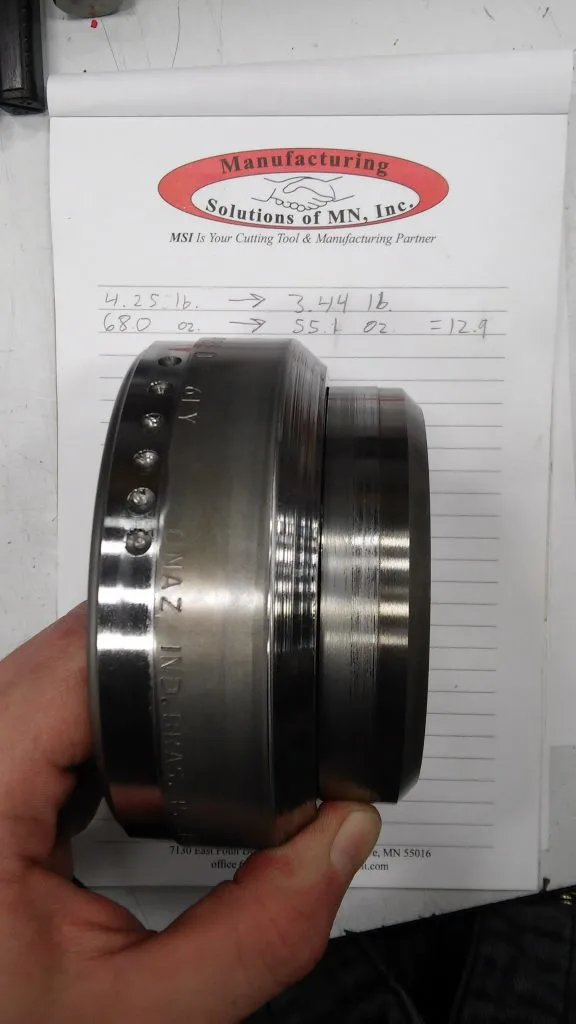
Bonus Mod: Gearing
One more mod that will make a big difference on your CRF230 is changing the gearing. Stock gearing is a 13 tooth front and 51 tooth rear sprocket.
First gear is so low that it's almost unusable. Once you start adding power, you might as well start in second gear because it has plenty of torque to pull it from a standstill.
Here is the list of the 13 best CRF230 mods:
- Airbox
- Air filter
- Rejet
- Muffler
- Rear shock
- Forks
- Tires
- CDI Upgrade
- Exhaust
- Carb
- Big bore kit
- Camshaft
- Porting
- Flywheel key
- Lightened flywheel
- Adjustable camshaft sprocket
The best mod to ride with confidence on the trails
You can do all the mods you want to your CRF230F, but if you don't have proper riding technique, you're going to struggle staying in control on the trails. Want to get started on the right path to building your confidence? Click here to start learning proper riding technique.


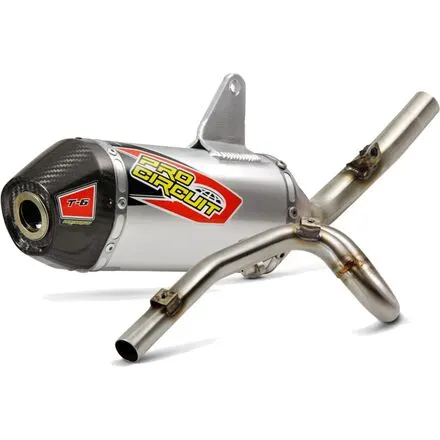
Tom Bolton
Sunday 16th of May 2021
I took an honest 16.2 pounds off my 2004 CRF230F and some other mods, what a difference!
This is my video: https://youtu.be/o5ovHodBLck
Kelley Fager
Sunday 16th of May 2021
Nice! They're fun bikes. Thanks for reading, Tom!
ben
Sunday 9th of May 2021
umm how much does it cost to replace the forks
Kelley Fager
Monday 10th of May 2021
Hey Ben, thanks for reading! It depends on which fork option you go with and how much work you do yourself. CR85 or XR400 forks can be found for around 400-500, but there's some parts and spacers that require machining, which can cost another 500+. A basic re-valve on the stock forks, which is the best budget option, is just over 100 bucks.
Ian Blyde
Wednesday 27th of January 2021
Hi all, - CRF230 off set crank pin, does anyone know where i can get/order a off set crank pin for my crf230, there's heaps of info about them out there but nothing about where you can buy one, if anyone can help please email their contracts to jennyandian@orcon.net.nz thanks for your help, Ian
Yannick Bolduc
Monday 26th of October 2020
Hi great blog !! been here and read it a lot since i have modified and have fun at doing so on my 230f :) i have a question regarding the carb swap for the PWK . When you change the carb do you have to change the cable wire ? or you can keep the pulling cable and it will connect in the PWK carb ? I just received my athena big bore kit and i think i will be better with a bigger carb or putting a #135 jet in the stock carb . Thank you very much for the creation of this blog and thx :)
Kelley Fager
Tuesday 27th of October 2020
Hey Yannick, thanks for the comment! I believe I changed to a CR85 throttle cable for the single pull. I would have to dig through my notes to check actual part numbers though. You will definitely like the bigger carb with the big bore once the jetting is properly set!
Thanks Kelley
Monday 3rd of August 2020
Great post. currently have a crf230f motor into a 1985 Honda 200x. Bolts right in other than the cylinder motor mounts.
I have frame clearance issues if i run the stock carb or a pd pumper and the pwk specs your running in the post was very helpful. Going to give one a try.
The old cr85's also use factory pwk 28's.
Much appreciated.
Kelley Fager
Tuesday 4th of August 2020
Ah, yes I've heard of some people swapping them into those things. Yeah, the stock carb is pretty large and cumbersome. What are you using for intake adapters? Yes, the later CR85 does have the PWK, but I believe it has a different slide as well as jets (a given). The slides are pretty expensive, which is why I ordered a new PWK and also had the idle screw installed on the right side for easy access on my 230.